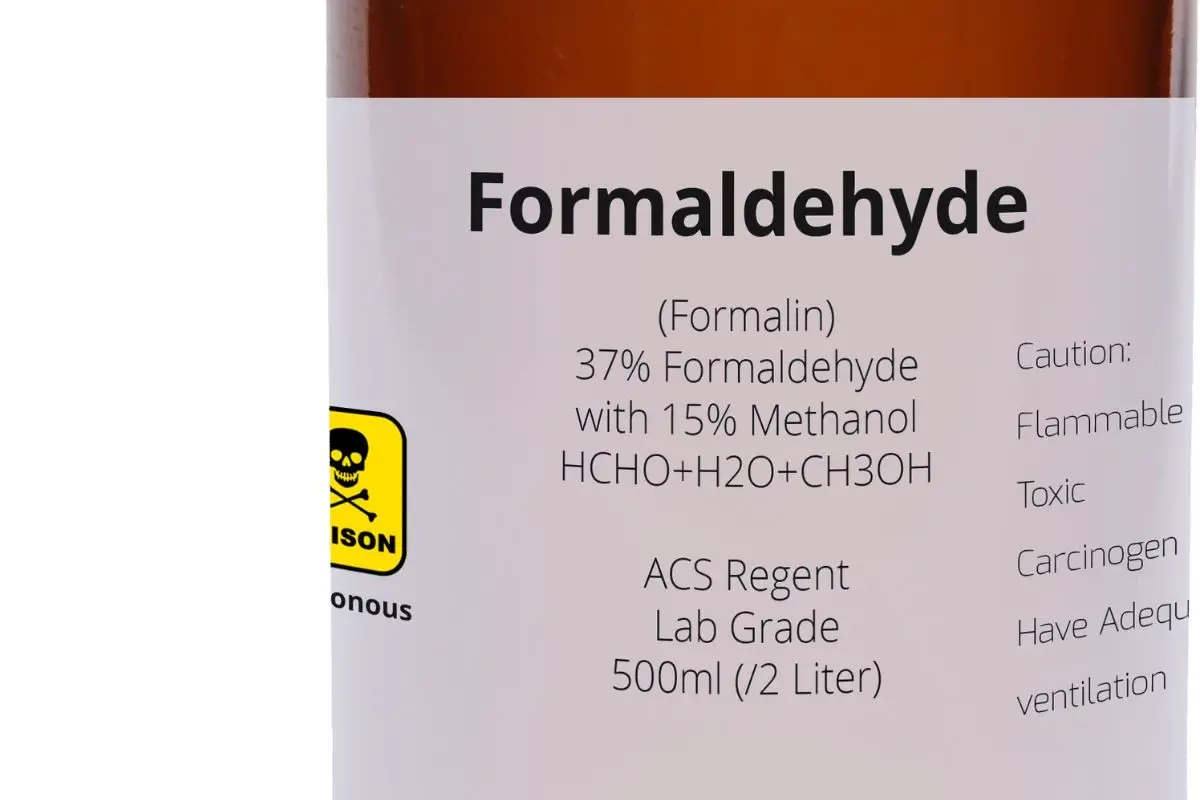Decaffeinated coffee has gained popularity among individuals who enjoy the taste and aroma of coffee but wish to limit their caffeine intake. However, there have been concerns and misconceptions regarding the use of formaldehyde in the decaffeination process. In this article, we will delve into the methods commonly used to remove caffeine from coffee beans and address the myth surrounding formaldehyde.

By examining the health and safety considerations involved in decaffeination, we aim to provide readers with a comprehensive understanding of the topic, enabling them to make informed choices when selecting safe and high-quality decaffeinated coffee.
Imagine sipping a warm cup of decaffeinated coffee on a peaceful morning, feeling refreshed and ready to tackle the day ahead. It is a comforting experience, as the absence of caffeine allows you to enjoy the rich flavors without the jitters and sleep disturbances that can accompany regular coffee consumption. However, amidst this serene moment, a question may arise: Is formaldehyde used in the process of making decaffeinated coffee?
This concern has circulated among coffee enthusiasts, leading to doubts about the safety and quality of decaffeinated coffee. In this article, we will delve deep into the decaffeination process, explore the common methods employed, and debunk the myth surrounding formaldehyde. By doing so, we hope to equip readers with the knowledge necessary to make informed choices and enjoy their decaffeinated coffee with peace of mind.
The Decaffeination Process: How is Caffeine Removed from Coffee Beans?
The decaffeination process involves the removal of caffeine from coffee beans through various methods, ensuring that the end product maintains its flavor and aroma while catering to those who prefer a lower caffeine content in their coffee.
This process is essential for individuals who are sensitive to caffeine or prefer to limit their intake due to health concerns. By understanding the decaffeination process, coffee lovers can make informed choices about their preferred brew.
One common method of decaffeination is the Swiss Water Process, which uses water and activated carbon filters to remove caffeine. In this process, green coffee beans are soaked in hot water, which extracts the caffeine along with the other soluble compounds.
The resulting liquid, known as ‘flavor-charged water,’is passed through activated carbon filters that selectively trap the caffeine molecules, while allowing the flavor compounds to pass through. The decaffeinated coffee beans are then reintroduced to this filtered water, allowing them to reabsorb the flavor compounds while remaining free of caffeine. This method is known for producing decaffeinated coffee with a full-bodied taste and minimal loss of flavor.
Another commonly used method is the direct solvent method, where a solvent, such as methylene chloride or ethyl acetate, is used to extract caffeine from the coffee beans. In this process, the green coffee beans are steamed to open their pores, allowing the solvent to penetrate and dissolve the caffeine molecules. The solvent is then evaporated, leaving behind decaffeinated coffee beans.
While this method is efficient in removing caffeine, there is a concern about the potential residues of the solvents in the final product. However, stringent regulations and quality control measures ensure that the residual solvent levels are well below the safety limits set by regulatory authorities.
The decaffeination process offers coffee enthusiasts the opportunity to enjoy their favorite beverage without the stimulating effects of caffeine. Understanding the various methods used in the decaffeination process allows consumers to choose a method that aligns with their preferences and safety concerns.
In the next section, we will explore the common methods of decaffeination in more detail, shedding light on their advantages and potential drawbacks.
Common Methods of Decaffeination
One widely employed approach to removing caffeine from coffee involves employing various methods of decaffeination. These methods can be broadly categorized into two main types: solvent-based and non-solvent-based.
Solvent-based methods, such as the direct and indirect solvent methods, use organic solvents like methylene chloride or ethyl acetate to extract caffeine from the coffee beans. In the direct solvent method, the beans are soaked in the solvent, which selectively dissolves and removes the caffeine. In the indirect solvent method, the beans are first steamed to open their pores, and then the solvent is used to extract the caffeine.
Non-solvent-based methods, on the other hand, rely on other techniques to remove the caffeine, such as the Swiss Water Process or the carbon dioxide method.
The Swiss Water Process is a chemical-free method that uses only water to extract caffeine from coffee beans. In this process, the beans are soaked in hot water, which dissolves the caffeine. The water is then passed through activated carbon filters that selectively remove the caffeine molecules. The beans are then re-immersed in the decaffeinated water, which allows them to reabsorb the flavor compounds without the caffeine. This method is often preferred by those who want to avoid the use of solvents in the decaffeination process.
The carbon dioxide method of decaffeination is another solvent-free approach. It involves using pressurized carbon dioxide to extract caffeine from the coffee beans. The beans are first moistened with water and then placed in a sealed chamber. Carbon dioxide is introduced into the chamber, which acts as a solvent and selectively removes the caffeine. After the caffeine is extracted, the carbon dioxide is depressurized, allowing it to return to its gaseous state and leaving behind decaffeinated coffee beans. This method is considered safe and effective, as carbon dioxide is a naturally occurring compound and is non-toxic.
Various methods of decaffeination are employed to remove caffeine from coffee beans. These methods can be solvent-based or non-solvent-based, with the Swiss Water Process and the carbon dioxide method being popular solvent-free approaches. These methods are safe and effective, providing consumers with decaffeinated coffee options without the use of harmful chemicals.
Debunking the myth surrounding the use of formaldehyde in the decaffeination process, it is important to note that none of the commonly used methods involve the use of this compound.
Debunking the Formaldehyde Myth

Contrary to popular belief, the decaffeination methods commonly employed do not involve the use of harmful chemicals such as formaldehyde. There are several misconceptions surrounding the use of formaldehyde in the decaffeination process, but it is important to debunk these myths and provide accurate information.
- Water Process: One of the most widely used methods of decaffeination is the water process, also known as the Swiss water process. In this method, green coffee beans are soaked in hot water to extract the caffeine. The water is then passed through activated charcoal filters, which selectively remove the caffeine molecules. This process does not involve the use of any harmful chemicals and is considered to be a safe and natural way to decaffeinate coffee.
- Carbon Dioxide Process: Another common method used for decaffeination is the carbon dioxide (CO2) process. In this method, liquid CO2 is used to extract the caffeine from the coffee beans. The beans are soaked in water and then pressurized with CO2, which causes the caffeine to dissolve. The CO2 is then evaporated, leaving behind decaffeinated coffee beans. This process is also chemical-free and does not pose any health risks.
- Organic Solvents: While it is true that some decaffeination methods use organic solvents, such as ethyl acetate or methylene chloride, these solvents are not harmful when used in controlled conditions. The solvents are used to dissolve the caffeine from the coffee beans, and then they are thoroughly removed during the drying process. The residual amounts of solvents in decaffeinated coffee are well below the safety limits set by regulatory authorities. Therefore, there is no need to worry about the presence of formaldehyde or any other harmful chemicals in decaffeinated coffee.
The common methods of decaffeination, such as the water process and the carbon dioxide process, do not involve the use of harmful chemicals like formaldehyde. While some methods may use organic solvents, the residual amounts are extremely low and well within safety limits. Consumers can enjoy decaffeinated coffee without any health concerns.
Moving forward, it is important to consider health and safety considerations when choosing decaffeination methods.
Health and Safety Considerations
This discussion will delve into the potential risks associated with formaldehyde exposure, as well as the regulatory oversight and consumer protection measures in place.
Formaldehyde is known to be a potentially hazardous substance, with exposure linked to various health concerns such as respiratory issues and cancer.
Regulatory agencies play a crucial role in setting limits and standards for formaldehyde levels in consumer products, ensuring the safety and protection of the general public.
Potential Risks of Formaldehyde Exposure
The potential risks of formaldehyde exposure are a significant concern when evaluating the use of formaldehyde in the production of decaffeinated coffee. Formaldehyde is a colorless, strong-smelling gas that is known to be a human carcinogen. It has been classified as a Group 1 carcinogen by the International Agency for Research on Cancer (IARC), meaning that there is sufficient evidence to conclude that formaldehyde causes cancer in humans. Exposure to formaldehyde can occur through various routes, including inhalation, ingestion, and skin contact. When formaldehyde is used in the decaffeination process of coffee production, there is a potential risk of formaldehyde residues remaining in the final product. This raises concerns about the potential health effects of consuming decaffeinated coffee that has been treated with formaldehyde.
To better understand the potential risks of formaldehyde exposure, it is important to examine the effects it can have on the human body. Formaldehyde is primarily known for its ability to cause respiratory irritation, such as coughing, wheezing, and shortness of breath. Prolonged or high-level exposure to formaldehyde has also been linked to an increased risk of developing certain types of cancer, including nasopharyngeal cancer and leukemia. In addition, formaldehyde has been shown to have reproductive and developmental effects, and it may also cause allergic reactions in some individuals.
To provide a clearer picture of the potential risks of formaldehyde exposure, the table below summarizes some of the known health effects associated with formaldehyde exposure at different levels:
| Formaldehyde Level | Health Effects |
|---|---|
| Low levels (0.1-1 ppm) | Eye and respiratory irritation, allergic reactions |
| Moderate levels (1-10 ppm) | Increased risk of respiratory symptoms, asthma exacerbation |
| High levels (>10 ppm) | Increased risk of cancer, reproductive and developmental effects |
Considering these potential risks, it is crucial for regulatory oversight and consumer protection to ensure that formaldehyde residues in decaffeinated coffee are kept within safe limits.
Regulatory Oversight and Consumer Protection
The potential risks associated with formaldehyde exposure have raised concerns among consumers. As a result, regulatory agencies have implemented oversight measures to protect the public and ensure the safety of various products, including decaffeinated coffee.
In the United States, the Food and Drug Administration (FDA) is responsible for regulating the use of formaldehyde in food and beverages. They have established strict guidelines and limits on the amount of formaldehyde that can be present in these products.
The FDA has deemed formaldehyde safe for consumption in small quantities, as long as it does not exceed the regulatory limits. They conduct regular inspections and testing to ensure that manufacturers comply with these guidelines. Additionally, the FDA requires manufacturers to accurately label their products, including any potential risks or allergens, providing consumers with the necessary information to make informed choices.
Transitioning into the subsequent section about choosing safe and high-quality decaffeinated coffee, it is important for consumers to be aware of the various factors that contribute to a product’s safety. By understanding the regulatory oversight and consumer protection measures in place, consumers can make informed decisions about the decaffeinated coffee they purchase.
Choosing Safe and High-Quality Decaffeinated Coffee

When choosing safe and high-quality decaffeinated coffee, it is important to consider reading labels and certifications. By carefully reading the labels, consumers can determine if the coffee has undergone a safe decaffeination process and if it meets certain quality standards.
Additionally, looking for certifications such as Fair Trade or Organic can provide reassurance that the coffee has been produced using environmentally friendly and socially responsible practices.
Trusting reputable brands and suppliers is another crucial factor in ensuring the safety and quality of decaffeinated coffee, as established companies often have rigorous quality control procedures in place.
Reading Labels and Certifications
Certifications and labels on coffee packaging provide valuable information to consumers regarding the presence or absence of formaldehyde in the decaffeination process.
One important certification to look for is the Swiss Water Process (SWP) certification. The SWP is a non-chemical decaffeination method that uses only water, temperature, and time to remove caffeine from coffee beans. This process ensures that no formaldehyde or other harmful chemicals are used in the decaffeination process.
Additionally, the USDA Organic certification is another label to consider. Organic coffee is grown without the use of synthetic pesticides, herbicides, and fertilizers, which reduces the risk of chemical contamination throughout the entire coffee production process.
Furthermore, some labels may specifically state that no formaldehyde or other chemicals were used in the decaffeination process. These labels provide consumers with reassurance that the coffee they are purchasing is free from potentially harmful substances.
By carefully reading and understanding the certifications and labels on coffee packaging, consumers can make informed choices and select decaffeinated coffees that prioritize safety and quality.
Transitioning into the subsequent section about trusted brands and suppliers, it is important to note that certifications and labels are just one aspect of ensuring the safety of decaffeinated coffee.
In the next section, we will explore the importance of choosing trusted brands and suppliers that have a reputation for prioritizing consumer safety and quality control measures.
Trusted Brands and Suppliers
Reputable brands and suppliers play a pivotal role in ensuring the safety and quality of decaffeinated coffee. These brands understand the importance of using safe and reliable methods to remove caffeine from coffee beans without compromising the flavor and aroma. By partnering with trusted suppliers, they can source high-quality coffee beans that are free from harmful substances and contaminants.
When it comes to decaffeinated coffee, trusted brands and suppliers take several measures to ensure the safety of their products. Firstly, they prioritize the use of natural decaffeination methods, such as the Swiss Water Process or the carbon dioxide method. These methods do not involve the use of formaldehyde or any other potentially harmful chemicals.
Secondly, reputable brands and suppliers carefully select their coffee beans and ensure that they come from reliable sources. This includes working with organic and fair-trade certified farms, where coffee beans are grown without the use of pesticides or other harmful substances.
Lastly, these brands and suppliers adhere to strict quality control processes, including regular testing of their products for any potential contaminants. This ensures that consumers can enjoy their decaffeinated coffee with peace of mind, knowing that it has undergone rigorous safety checks.
Reputable brands and suppliers play a crucial role in ensuring the safety and quality of decaffeinated coffee. Through their commitment to natural decaffeination methods, careful sourcing of coffee beans, and rigorous quality control processes, they provide consumers with a safe and enjoyable coffee experience. By choosing decaffeinated coffee from trusted brands and suppliers, consumers can satisfy their subconscious desire for safety while indulging in their favorite beverage.
Frequently Asked Questions
Are there any health risks associated with consuming decaffeinated coffee?
There are no significant health risks associated with consuming decaffeinated coffee. It is a safe alternative for individuals who want to avoid the stimulating effects of caffeine.
How does the decaffeination process affect the taste and aroma of coffee?
The decaffeination process can alter the taste and aroma of coffee due to the removal of caffeine. However, it is important to note that there are various methods used, such as solvent-based or water-based, which can affect the final flavor and scent. One interesting statistic reveals that solvent-based methods, like methylene chloride, can retain more of the original flavor compared to water-based processes.
Is decaffeinated coffee less acidic than regular coffee?
Decaffeinated coffee tends to be less acidic than regular coffee due to the decaffeination process. This process can involve various methods, such as Swiss water process or direct solvent extraction, which remove caffeine while also reducing acidity levels.
Can decaffeinated coffee still provide an energy boost?
Decaffeinated coffee, although lacking caffeine, can still provide an energy boost to some extent due to the presence of other compounds like antioxidants. However, it is important to note that the level of energy boost may be lower compared to regular coffee.
Does decaffeinated coffee have the same amount of antioxidants as regular coffee?
Decaffeinated coffee generally contains a similar amount of antioxidants as regular coffee. Antioxidant levels are influenced by the coffee bean variety and processing methods, rather than the presence of formaldehyde in the decaffeination process.
Conclusion
In conclusion, formaldehyde is not used in the process of decaffeinating coffee. Various methods are employed to remove caffeine from coffee beans, including the Swiss Water Process, direct solvent method, and carbon dioxide method. These methods ensure that the decaffeinated coffee produced is safe for consumption. The myth surrounding formaldehyde in decaffeinated coffee is unfounded and lacks scientific evidence.
It is important to consider health and safety considerations when choosing decaffeinated coffee. Consumers should opt for reputable brands that adhere to strict quality control measures and use approved decaffeination methods.
Additionally, individuals with specific health concerns or sensitivities should consult with their healthcare provider before consuming decaffeinated coffee.
To engage the audience, let us consider a hypothetical example. Imagine a coffee lover named Sarah who is highly sensitive to caffeine. She loves the taste of coffee but experiences sleep disturbances and anxiety when consuming regular coffee. After researching different decaffeination methods, Sarah decides to try a high-quality decaffeinated coffee that uses the Swiss Water Process. She finds that she can enjoy her favorite beverage without the unwanted effects of caffeine, allowing her to continue her love for coffee while maintaining her well-being.
This example highlights the importance of choosing safe and high-quality decaffeinated coffee for individuals with caffeine sensitivities.
Related articles: